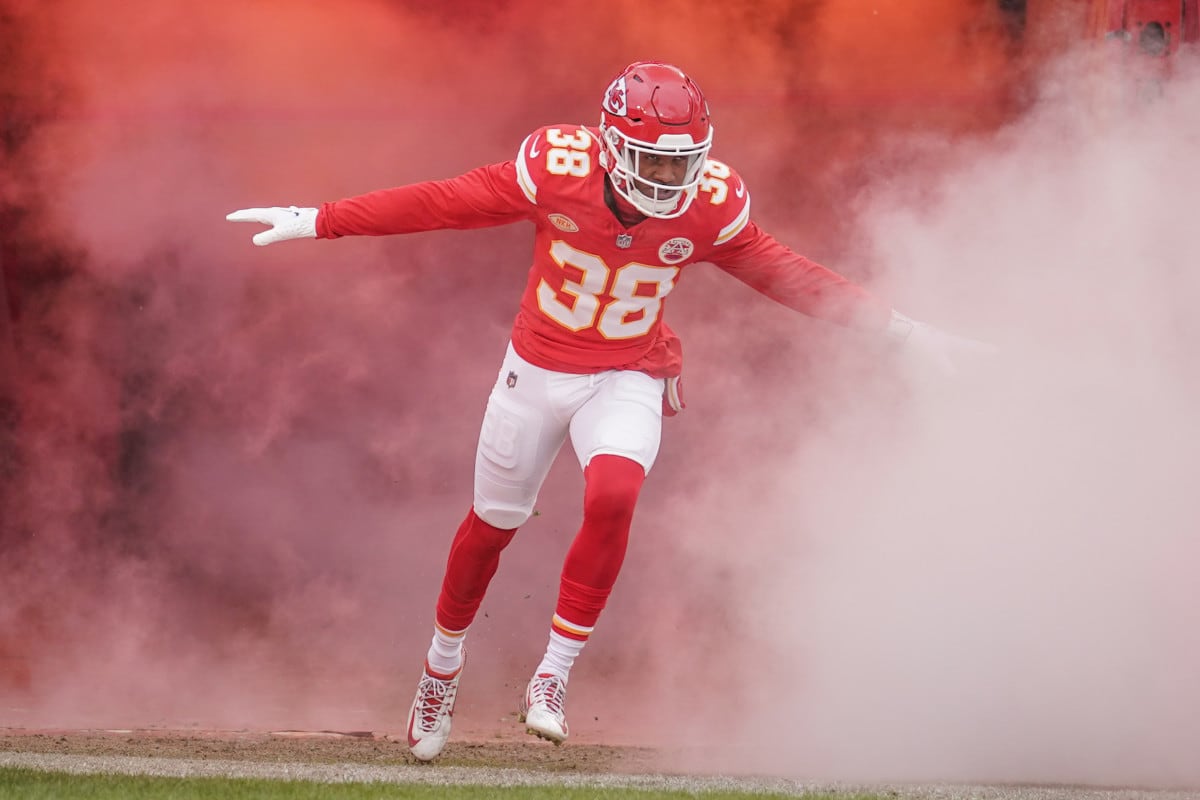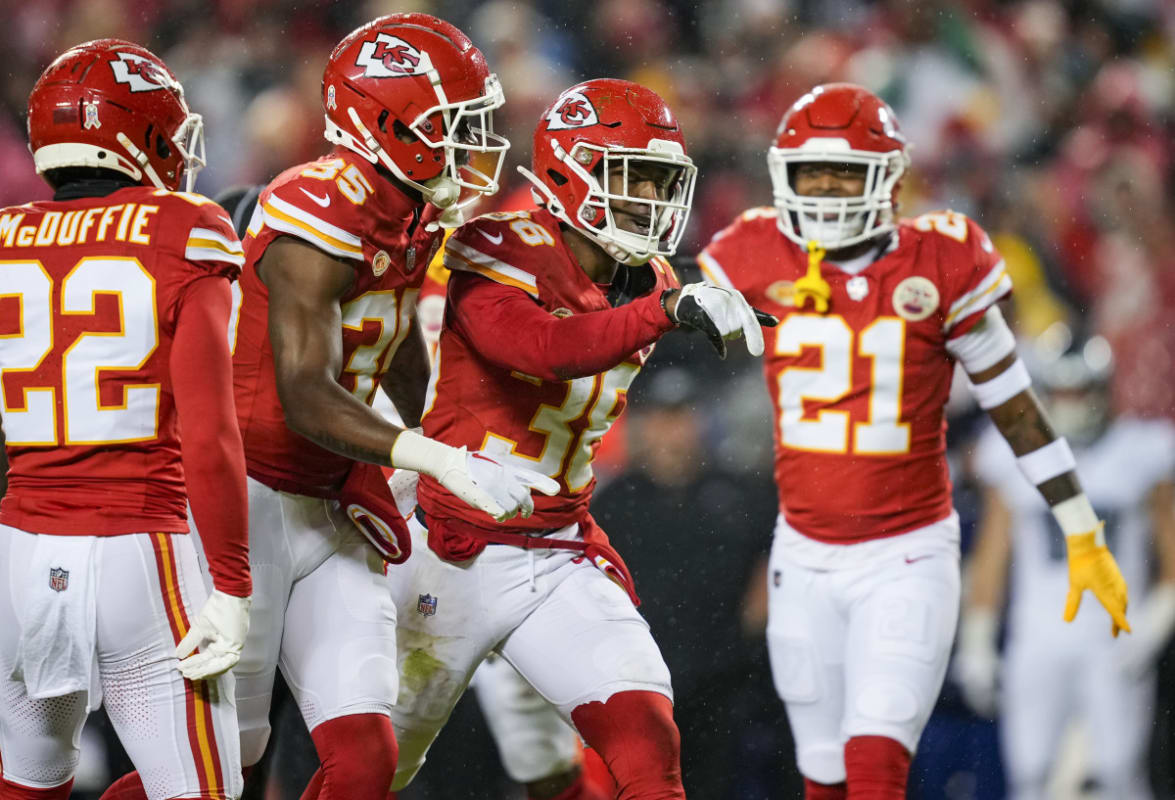There were maybe 26 hours left before Super Bowl LVIII kickoff when the Kansas City Chiefs buses pulled into the team hotel in Lake Las Vegas. The architect of their budding dynasty exited alongside the players he signed, traded for and drafted.
He looked tired, Brett Veach did, on the eve of another title game. The physical difference between where the team stayed and where its friends and family bunkered had meant hours in traffic, heading back and forth to the strip. The season—which opened with a loss, went up, then lower than ever, then righted, shakily, just as the playoffs began—had exacted a considerable toll. Big decisions loomed: What would he do about Chris Jones? L’Jarius Sneed? They loomed as “good” problems, part of the business of not just building a team that would demand to be remembered, but also sustaining it in a league that’s set up to make continued success almost impossible.

Denny Medley/USA TODAY Sports
Soon, the Chiefs would take the field for another Super Bowl. They would fall behind the San Francisco 49ers, storm back, bank another round of Patrick Mahomes magic for the time capsule and become the first NFL team in two decades to repeat as champions. But that previous afternoon Veach was explaining the work of an architect confined by so many parameters that were directly related to the success of the team he built. He sometimes chose his phrasing carefully, not wanting to sound boastful or appear eager for credit.
Still, he did—does—believe that Kansas City operates within a distinct approach, one that’s equal parts steeped in history and modernized; one that values scouts’ takes and relies sometimes on gut feel; one that, in many ways, is similar to methods that define other franchises, but, in other ways, isn’t like them at all. Veach, in explaining what distinguishes KC, pointed to one player that casual Kingdom fans might not have expected. It wasn’t Mahomes, Jones or Travis Kelce. It was Sneed, the fourth-year cornerback from Louisiana Tech who Veach drafted in 2020—the same player the Chiefs placed their non-exclusive franchise tag on Monday. The move registered surprise in some quarters because of Sneed’s value relative to the price tag he commands. He can seek a long-term deal elsewhere, and, if he signs one, Kansas City can do no more than match it.
Drafting Sneed began a defensive overhaul that continued even through the Super Bowl LVIII triumph over San Francisco. That season, Sneed joined a solid-but-aging defensive core, just as Mahomes’s career continued to solidify as legendary. Kansas City already knew that it could win games by scoring touchdowns and breaking scoreboards. But Veach and its other top decision makers also understood that, with salary cap restrictions and the unintended consequences of too much winning ever-present, the Chiefs’ approach would need to remain adaptable. Especially if they wanted to add another Lombardi Trophy to the display case at team headquarters.
The defense continued to get older. The offense continued to see elite players, such as wideout Tyreek Hill, depart. Throughout, Veach clung to his plan. He adapted. And in 2021, he decided the defensive overhaul needed to be cranked up.
In the past two drafts, Veach selected 12 defenders. Eleven were DBs or defensive linemen. The makeover was intentional and necessary in light of Mahomes’s contract, Hill’s departure and the ever-shifting nature of NFL roster shaping. That started with Sneed. Viewed another way, the cornerback’s drafting helps explain how a dynasty was built, then failed to materialize, then formed, finally in full, this past February.
It starts with Steve Spagnuolo retaining influence in Kansas City’s evaluation process, same as always, with all coaches. But Veach prefers a less typical twist: the front office whittles down the total number of prospects, then asks coordinators for independent analyses. With fewer prospects to study, Veach believes coaches return more accurate assessments.
After the Chiefs won Super Bowl LIV in early 2020, Sneed was one player in that smaller pool who reached Spagnuolo’s desk and laptop. Evaluators had put Sneed in the third tier of their rating system, but Kansas City wanted a deeper look. Spags did his own breakdown and told Veach he loved Sneed—as much as any safety in any tier. They snagged Sneed in the fourth round in 2020; at the time, especially in terms of draft capital versus the franchise’s evaluation, Veach considered the pick good value.
As it turns out, Sneed was much more than that. The cornerback snagged three interceptions in his rookie season, tied as 10th most for a first-year defender in franchise history—a group that includes elite secondary players such as Deron Cherry and Eric Berry. In 2022, Sneed became one of two players in the entire league to finish the season with at least 100 tackles, at least three sacks and at least three picks (108, 3.5 and 3.0, respectively). That year, the Chiefs would topple the Eagles in Super Bowl LVII.

Jay Biggerstaff/USA TODAY Sports
Still, drafting or signing more than a dozen players to fill a starting defense in two years doesn’t guarantee they’ll live up to collective expectations. Veach augmented the youth movement with four veteran defenders, and Spagnuolo took over from there, shaping them into a force. Even in August, Veach didn’t necessarily believe the Chiefs would showcase one of the NFL’s top defenses, but Mahomes did tell the GM he wasn’t enjoying practice all that much against this new, young, swarming unit that Kansas City had assembled.
As Super Bowl LVIII approached, Andy Reid gushed over the cornerback’s development. “We’ve just seen him grow,” Reid said, while noting that Sneed’s role had expanded to often include covering slot receivers as the nickel corner. “Very well-rounded.”
If he appreciated the compliment, Sneed was too engaged in preparation to brag about his versatility. Instead, he described his approach as simple. He always told the coaches, “Put me where you need me.” They did, and he excelled, each time.
Sneed seems introspective that way. He also described how losing the AFC championship game against the Cincinnati Bengals in early 2022 haunted him and other young defenders. He had told them not to put their heads down that night, to get up and get ready to come back. They would. They did.
Kansas City’s defense harassed quarterbacks, while the yikes-young secondary—2022 draft picks Trent McDuffie, Jaylen Watson and Joshua Williams all started, along with Sneed—gained experience. Near the end of the shakiest of championship seasons yet, Reid told Sports Illustrated he noticed “tighter” zones in the Chiefs’ coverage. McDuffie blanketed slot receivers as well as any cornerback in the NFL, and Sneed finished fourth in the league in expected points per target (-0.33). Kansas City finished first this postseason in expected points allowed (-0.072), limiting the Baltimore Ravens to a mere three third-down conversions in 11 attempts along the way.
The Chiefs won their third Super Bowl in five seasons thanks to Sneed, Spagnuolo and Veach; thanks to that defensive overhaul; and thanks to that evaluation process, all the winnowing that becomes more like an exercise in mining for football prospect gold. If that now means Kansas City will lose Sneed, like Hill, to a team with the capability to pay more, so be it. Veach, on the afternoon before the title game, wanted Sneed back, recognizing his value and hoping to find a resolution in the months ahead. That doesn’t appear to have happened—yet. But Veach will cling to the process, either way. After all, there’s a three-peat to hunt for and a defense that should only be better than it’s already elite 2023 season.






